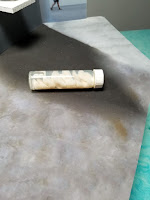Extra Credit Event 2: Coyotes in Two Directions, Sarah Brady

I visited Sarah Brady exhibition opening: Coyotes in Two Directions on June 7 at Art | Sci Center Gallery, CNSI Building at UCLA. I did not know about the Coyotes, before I attended to this event. According to the researches, Coyote is an animal, canine. They look similar to wolves. According to the explanation by Sarah Brady, this exhibition examines the signifier of the trickster and shapeshifter as a symbolic metaphor to create techno-hybrid forms. They said coyotes are the symbol of mythology and surviving under Anthropocene, the human impact on Eco-System. First time, I get this information I did not really get what does this statement mean. However, as soon as I saw the art crafts, I recognized the meaning of this statement. As I entered the exhibition, this one came in my sight first. I think this is the thing I saw at the earlier exhibition, Weak or No Signal. This craft was named as "Aposematic". It has one leg and six moving arms. The difference between the ...




